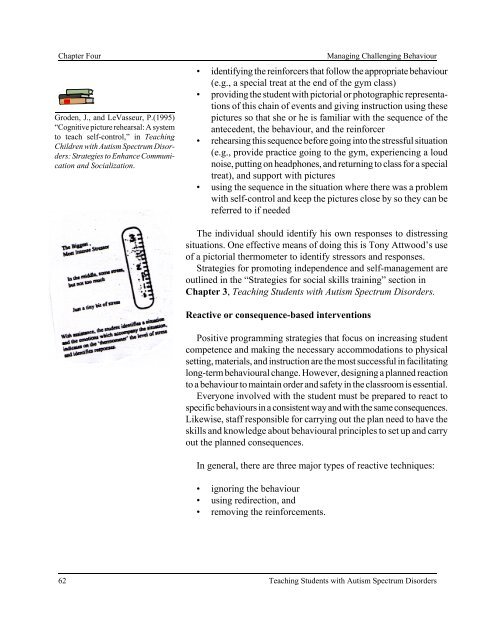Teaching Students with Autism Spectrum Disorders
Teaching Students with Autism Spectrum Disorders
Teaching Students with Autism Spectrum Disorders
You also want an ePaper? Increase the reach of your titles
YUMPU automatically turns print PDFs into web optimized ePapers that Google loves.
Chapter Four Managing Challenging Behaviour<br />
Groden, J., and LeVasseur, P.(1995)<br />
“Cognitive picture rehearsal: A system<br />
to teach self-control,” in <strong>Teaching</strong><br />
Children <strong>with</strong> <strong>Autism</strong> <strong>Spectrum</strong> <strong>Disorders</strong>:<br />
Strategies to Enhance Communication<br />
and Socialization.<br />
• identifying the reinforcers that follow the appropriate behaviour<br />
(e.g., a special treat at the end of the gym class)<br />
• providing the student <strong>with</strong> pictorial or photographic representations<br />
of this chain of events and giving instruction using these<br />
pictures so that she or he is familiar <strong>with</strong> the sequence of the<br />
antecedent, the behaviour, and the reinforcer<br />
• rehearsing this sequence before going into the stressful situation<br />
(e.g., provide practice going to the gym, experiencing a loud<br />
noise, putting on headphones, and returning to class for a special<br />
treat), and support <strong>with</strong> pictures<br />
• using the sequence in the situation where there was a problem<br />
<strong>with</strong> self-control and keep the pictures close by so they can be<br />
referred to if needed<br />
The individual should identify his own responses to distressing<br />
situations. One effective means of doing this is Tony Attwood’s use<br />
of a pictorial thermometer to identify stressors and responses.<br />
Strategies for promoting independence and self-management are<br />
outlined in the “Strategies for social skills training” section in<br />
Chapter 3, <strong>Teaching</strong> <strong>Students</strong> <strong>with</strong> <strong>Autism</strong> <strong>Spectrum</strong> <strong>Disorders</strong>.<br />
Reactive or consequence-based interventions<br />
Positive programming strategies that focus on increasing student<br />
competence and making the necessary accommodations to physical<br />
setting, materials, and instruction are the most successful in facilitating<br />
long-term behavioural change. However, designing a planned reaction<br />
to a behaviour to maintain order and safety in the classroom is essential.<br />
Everyone involved <strong>with</strong> the student must be prepared to react to<br />
specific behaviours in a consistent way and <strong>with</strong> the same consequences.<br />
Likewise, staff responsible for carrying out the plan need to have the<br />
skills and knowledge about behavioural principles to set up and carry<br />
out the planned consequences.<br />
In general, there are three major types of reactive techniques:<br />
• ignoring the behaviour<br />
• using redirection, and<br />
• removing the reinforcements.<br />
62 <strong>Teaching</strong> <strong>Students</strong> <strong>with</strong> <strong>Autism</strong> <strong>Spectrum</strong> <strong>Disorders</strong>

















